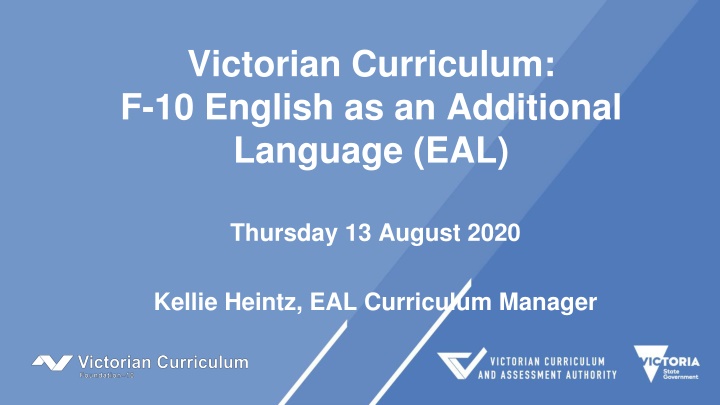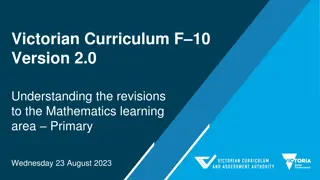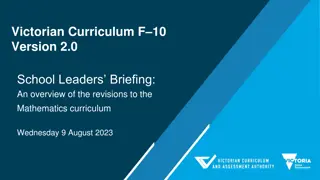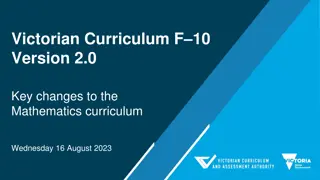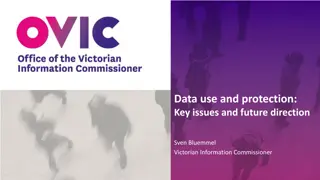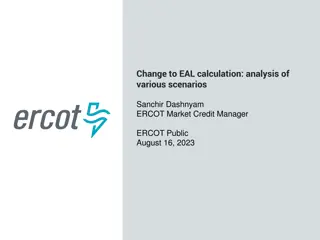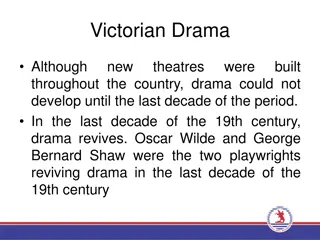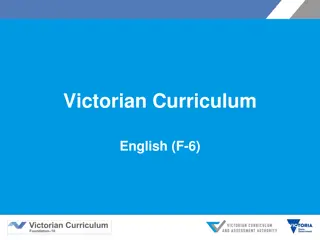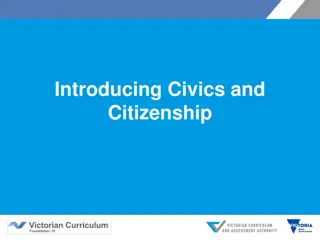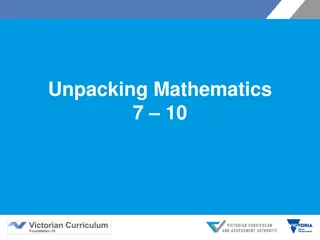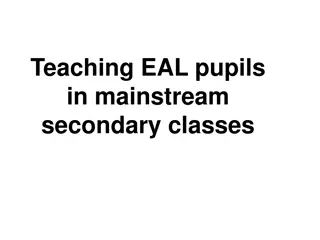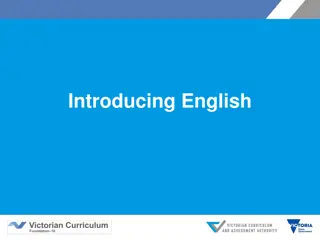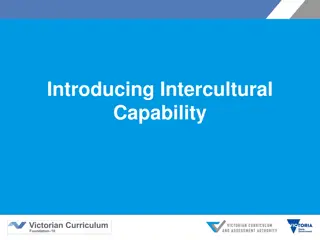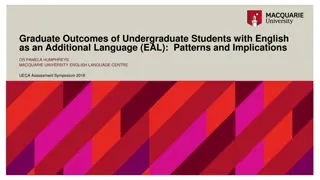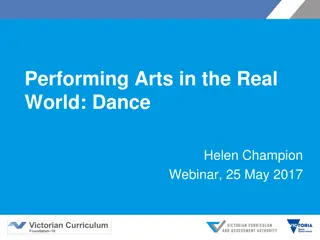Implementing Victorian F-10 EAL Curriculum
This presentation focuses on utilizing the Victorian F-10 EAL Curriculum for teachers new to instructing EAL students. It covers considerations for schools, different content areas, pathways A, B, and C, as well as strategies for navigating the curriculum and promoting plurilingualism. The significance of implementing the EAL Curriculum across all subject areas in schools is highlighted, emphasizing the responsibility of all teachers in supporting EAL learners' language development and content understanding.
Download Presentation

Please find below an Image/Link to download the presentation.
The content on the website is provided AS IS for your information and personal use only. It may not be sold, licensed, or shared on other websites without obtaining consent from the author.If you encounter any issues during the download, it is possible that the publisher has removed the file from their server.
You are allowed to download the files provided on this website for personal or commercial use, subject to the condition that they are used lawfully. All files are the property of their respective owners.
The content on the website is provided AS IS for your information and personal use only. It may not be sold, licensed, or shared on other websites without obtaining consent from the author.
E N D
Presentation Transcript
Victorian Curriculum: F-10 English as an Additional Language (EAL) Thursday 13 August 2020 Kellie Heintz, EAL Curriculum Manager
Acknowledgment of Country In recognition of Aboriginal and Torres Strait Islander people s spiritual and cultural connection to country, we acknowledge the traditional custodians of the Kulin Nations. We acknowledge the continued care of the lands and waterways over generations and celebrate the continuation of a living culture that has a unique role in this region. We pay our respects to Elders past, present and emerging, for they hold the memories, traditions, culture and hopes of all Aboriginal and Torres Strait Islander peoples across the nation and hope they will walk with us on our journey.
Introduction This presentation is for teachers who are new to the teaching of EAL students. It will focus on: Using the Victorian F-10 EAL Curriculum Considerations to be made by schools Different content areas Unpacking Pathways: A, B and C Navigating the curriculum Plurilingualism
2021 In 2021, the Victorian Curriculum F-10 EAL will be mandated for implementation in both government and Catholic schools. Independent schools will be guided by their school.
Using the EAL Curriculum All teachers are responsible for teaching EAL learners in their subject areas, this involves: understanding the proficiency levels of their EAL students focusing on the content-specific language students need to access the content of their learning areas being able to plan for and support the language learning of EAL students in order to support their understanding of the different content
What does this mean for schools? The whole school is responsible for planning and implementing the new EAL curriculum. The expertise of specialist EAL teachers needs to be drawn upon. Specialist EAL teachers will need time to work with teachers of EAL students. In the absence of an EAL specialist, the literacy leader or English leader may need to take the lead with support from their school.
Step 1: some considerations Evaluating current EAL teaching and learning programs How well is the school s current EAL teaching and learning program differentiated to support EAL student learning? How well is the current EAL teaching and learning program aligned to the new EAL curriculum? What roles will the specialist EAL teacher, classroom teachers and subject teachers play in the implementation of the new curriculum?
Step 2: some considerations As a whole, the school will need to consider: the current forms of assessment used for EAL learners the pedagogical knowledge of teachers and the collective experience of teaching EAL learners the structure and flexibility of teaching plans to accommodate the EAL learners the current whole-school EAL approach and the adjustments that are required the way the new curriculum aligns to other school initiatives
Step 3: some considerations As a whole, the school will also need to consider: what needs to be changed about reporting on EAL student learning ways to provide resources to support teachers in their development and planning, for example, providing time for collaboration and the sharing of expertise or supporting attendance at relevant professional learning events.
What might this look like? The specialist English or EAL teacher/s meet with classroom teachers and subject teachers of EAL students to: review student assessment and identify a student s initial pathway on the EAL curriculum refer to the EAL curriculum for examples of appropriate language learning for that pathway consider how the content of a specific learning area may be adapted and scaffolded to support the student s access to language in that subject
Collaboration School leaders will need to consider how the implementation of the EAL curriculum impacts on the whole-school EAL approach. This may mean changing: how all teachers of EAL learners work together who is involved in EAL planning who has oversight of the EAL program Opportunities for specialist EAL teachers to work collaboratively with generalist primary teachers and/or secondary subject teachers will also need to be considered.
A curriculum across all learning areas The Victorian Curriculum F-10 EAL: recognises that students need to access and to demonstrate learning in all learning areas
Example of teaching content specific language in Science Content specific vocabulary Linguistic specific (verbs of instruction) place, measure, pour, set up, hold, point away, open, move and return Language for interaction Language for clarification test tube, test tube rack, 10ml measuring cylinder, heat proof mat, Bunsen burner, rubber hose, matches, wooden tongs first you , then , ok now you have to . sorry, can you repeat that? or what was the step again?
Example of teaching content specific language in PE Content specific vocabulary Linguistic specific (verbs of instruction) Play on, pass, run, kick, mark, contest, Language for interaction Non-Verbal Footy, pass, mark, behind, goal, point, kick, oval, boundary, umpire, ladder, Brownlow, handball, 50 meter line, possession, Move, run, over there, faster, get the ball, Clear goal, goal. Behind, high tackle, trip, start game, end game
Secondary English/EAL teachers Secondary English or EAL teachers report on the English language proficiency of their EAL students using the EAL curriculum.
Secondary school subject teachers Teachers who are not EAL specialists do not need to report on the English language proficiency of their EAL students. Teachers report on their learning area content, as is the current practice.
EAL Curriculum-content Overview of the EAL Curriculum Structure Pathways and levels Content descriptions Elaborations Achievement standards Resources and Glossary
Components of the curriculum Pathways and levels Language modes Speaking and Listening Reading and Viewing Writing Strands & sub-strands Communication Cultural and Plurilingual awareness Linguistic structures and features Content descriptions Elaborations Achievement standards
The pathways The Victorian Curriculum F-10 EAL is: a continuum structured as three EAL pathways (A, B, C). Each pathway describes a different stage of English-language learning (early, mid and late), and each pathway is divided into different levels of language learning (A1, A2, BL, B1, B2, B3, CL, C1, C2, C3, C4).
Understanding the pathways EAL Pathway A: Early immersion (Foundation Year 2) Early immersion language learners typically develop their literacy skills through experiences in the school context. Those who have had some experience of formal preschool or school will more readily adapt to the school setting. A student located on EAL Pathway A may have some experience of formal learning in their home language or other languages and some experience of informal prior learning. EAL Pathway A includes two levels of English-language learning: Level A1 and Level A2. Those with little or no experience of English begin at A1; those with some experience may begin at A2. The progress within these levels equates to the rates of progression expected in Foundation Year 2. Generally students who enter Foundation are pre-literate, regardless of their language background, and hence there is no Level AL. EAL students who enter Foundation with minimal literacy in other languages will begin their early immersion in English at Level A1.
Understanding the pathways EAL Pathway B: Mid immersion (Years 3 8) Mid immersion language learners have experience of the social use of language, which they can use as they learn English at school. A student located on EAL Pathway B may have some experience of informal learning in their home language or other languages. Some have yet to experience formal schooling, while others may have experienced formal learning that is equivalent to their English-speaking peers. This may have been in their home language or other languages. EAL learners with little or no English proficiency, fewer than two years of formal learning and minimal home literacy experience will begin this pathway at Level BL, before moving to Level B1. Learners with prior experience of formal learning but no proficiency in English begin at Level B1, and move through Levels B1, B2 and B3. The progress within these levels equates to the rates of progression expected in Years 3 8.
Understanding the pathways EAL Pathway C: Late immersion (Years 7 10) Late immersion language learners have a mature understanding of themselves and their relations with others in different social contexts, and are capable of understanding abstract ideas and relationships in their experience and learning about the world. EAL learners without prior formal learning and with minimal home language literacy experience will begin this pathway at Level CL, before moving to the other levels. Learners with prior experience of formal learning but no proficiency in English will begin on Level C1 and move through Levels C1, C2, C3 and C4. The progress within these levels equates to the rates of progression expected in Years 7 10.
Pathways and levels The English as an Additional Language (EAL) curriculum sets out what students are expected to learn and is designed as a continuum of learning structured as three pathways. The pathways are presented in scope and sequence charts to support teachers to easily see the progression and assist in planning teaching and learning programs to meet the diverse needs of students. These charts include the content descriptions and achievement standards. It is advised that they are read in conjunction with the introductory materials and the level descriptions in the curriculum. EAL Scope and Sequence Pathway A.docx (106 KB) EAL Scope and Sequence Pathway B.docx (116 KB) EAL Scope and Sequence Pathway C.docx (118 KB)
Learning in EAL Language Modes Speaking and Listening Reading and Viewing Writing Language Strands Communication Cultural and plurilingual awareness Linguistic structures and features
Strands and sub-strands Cultural & plurilingual awareness Cultural understanding s Linguistic structures & features Text structure and organisatio Communic ation n Grammatic al patterns Plurilingual strategies Word knowledge Grapho- phonics / phonology
Content Descriptions In each level ,mode, strand and sub-strand sits the content descriptions. These statements form the core of the curriculum. Content descriptions include the knowledge and skills; the intended content that is the major focus of the mode and strand to be taught. These statements inform the learning objectives teachers are expected to teach and students are expected to learn.
Content Descriptions Level B2 Level Writing Linguistic structures and features Text structure and organisation Language mode Strand Use headings and text formats appropriate to the task Sub-strand Write simple paragraphs with a logical sequence of sentences Content descriptions (Skills / actions that are teachable) Use simple time sequence markers and pronoun references to connect ideas in a text
Content Descriptions Use heading and text formats appropriate to the task. Write simple paragraphs with a logical sequence of sentences. Use simple time sequence markers and pronoun references to connect ideas in a text.
Elaborations An example of a content description and the elaborations to support it from the B2 scope and sequence chart B2 Writing Linguistic structures and features Text structure and organisation Content Description: Write simple paragraphs with a logical sequence of sentences (VCEALL388) Elaborations: grouping sentences about the same topic into a paragraph organising sentences using a simple sequence, for example chronological order of events or strong to weak arguments using key words to write a simple topic sentence that states the main idea of the paragraph
Elaborations An example of a content description and the elaborations to support it from the C2 scope and sequence chart C2 Speaking and Listening Communication Content description: Negotiate interactions with reliance on an attentive conversation partner (VCEALC610) Elaborations: expressing complex thoughts and feelings in familiar situations seeking assistance or feedback from speech partners to formulate or confirm corrected expressions clarifying and elaborating on meaning by recasting and defining what has been said
Achievement standards At the end of each level (A1, A2, BL, B1 ..) of the EAL Curriculum in each of the modes, Speaking & Listening, Reading & Viewing and Writing sit the Achievement Standard. These statements sum up what students,who have reached the respective standard have learned and are able to demonstrate. They are virtually unchanged from the Achievement Standards from the EAL Companion to AUSVELS, the predecessor to this curriculum. For example, the final sentence in the B2 Writing Achievement Standard states They use more advanced software functions to write, edit and present their texts. When planning, identifying the learning accomplishments in the achievement standards will assist teachers to focus planning, teaching and learning to the stated outcomes.
Navigating the EAL Curriculum Structure Taking a look at the Structure tab we see the articulation of the pathways. The EAL curriculum is organised by pathways, language modes and strands. Pathway A: Early immersion (Foundation Year 2) Pathway B: Mid immersion (Years 3-8) Pathway C: Late immersion (Years 7-10)
An online tour of the curriculum https://victoriancurriculum.vcaa.vic.edu.au/english/english -as-an-additional-language-eal/introduction/rationale-and- aims
Plurilingualism Strand: Cultural and plurilingual awareness Sub strand: Plurilingual awareness Plurilingual awareness refers to understanding that people can use knowledge of more than one language to learn and communicate. It involves understanding that all languages spoken or used by a person form a repertoire that can be drawn upon, rather than seeing proficiency in one language as having no impact on capacity to learn another.
Plurilingual strategies Provide opportunities for EAL learners to: draw on the linguistic and cultural repertoire of other languages to support the learning of both content and the English language
Plurilingual strategies Teachers can gain familiarity and apply the opportunities that the Content descriptions and Elaborations provide within the plurilingual strategies sub-strand. However it is not an area of the curriculum that is referenced in the Achievement Standards and as such it is not assessed.
Plurilingualism at work CL C1 C2 C3 C4 Distinguish spoken English from other languages and attempt to respond in English Use sentence patterns from home language to communicate ideas Transfer some simple language structures to other contexts Check understanding of classroom English by asking for clarification from other home language speakers Use home language to formulate speech in English and communicate ideas Transfer knowledge from home language to English learning Ask for the translation of specific words from other home language speakers Explain the home language meaning of unfamiliar English words and phrases to home language peers Clarify in home language to check understanding Discuss a point of language Use home language resources to support use of English Transfer academic and communication skills from home language to English Use home language resources to develop English Compare and contrast different ways of communicating meanings in home language and English Talk about cultural differences related to communication
Coming in October Plurilingualism Assessment and Reporting Whole-school planning
Contact For any questions concerning the EAL curriculum, please contact me: Kellie Heintz, EAL Curriculum Manager, VCAA Kellie.Heintz@education.vic.gov.au or eal@education.vic.gov.au
